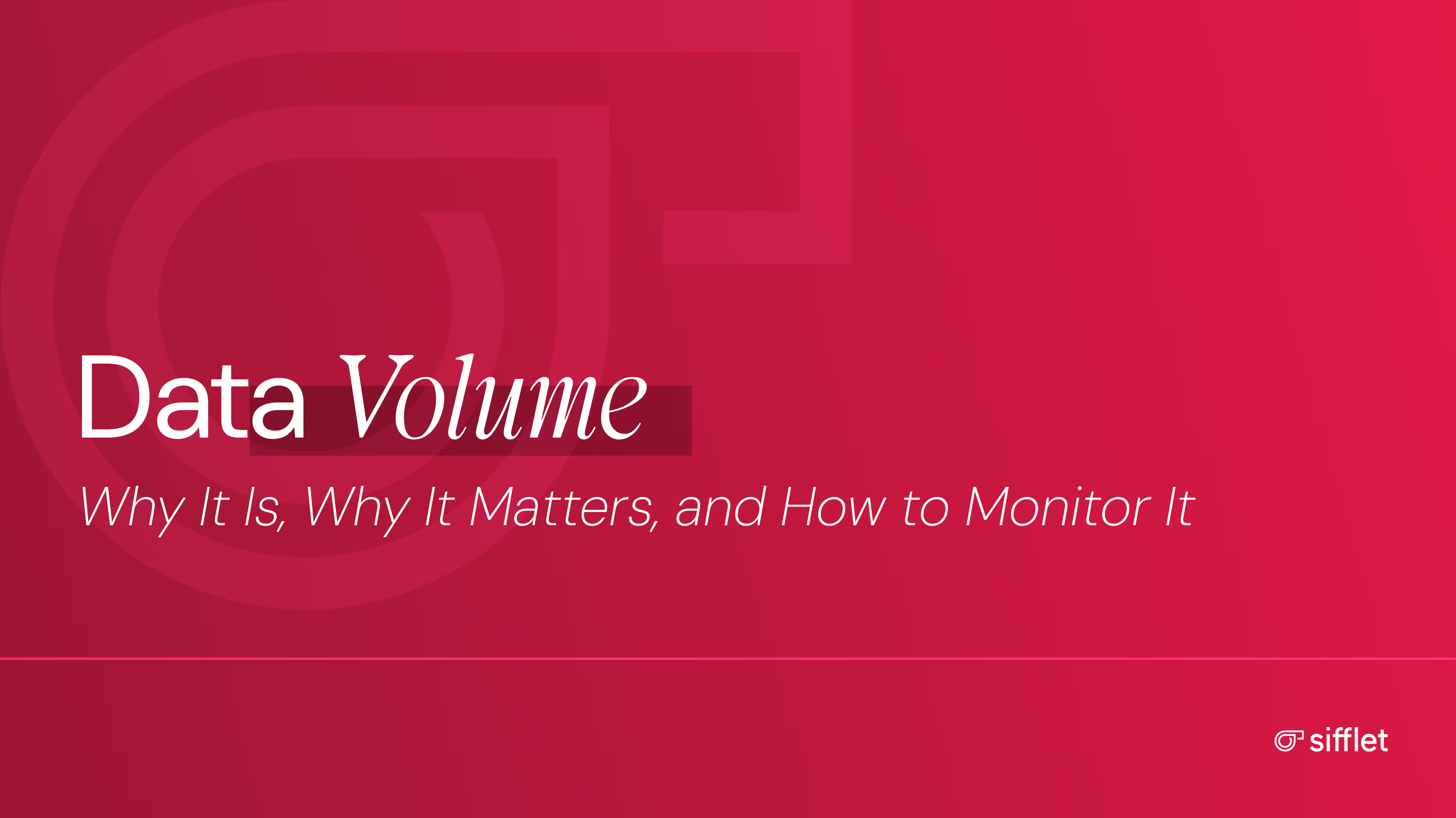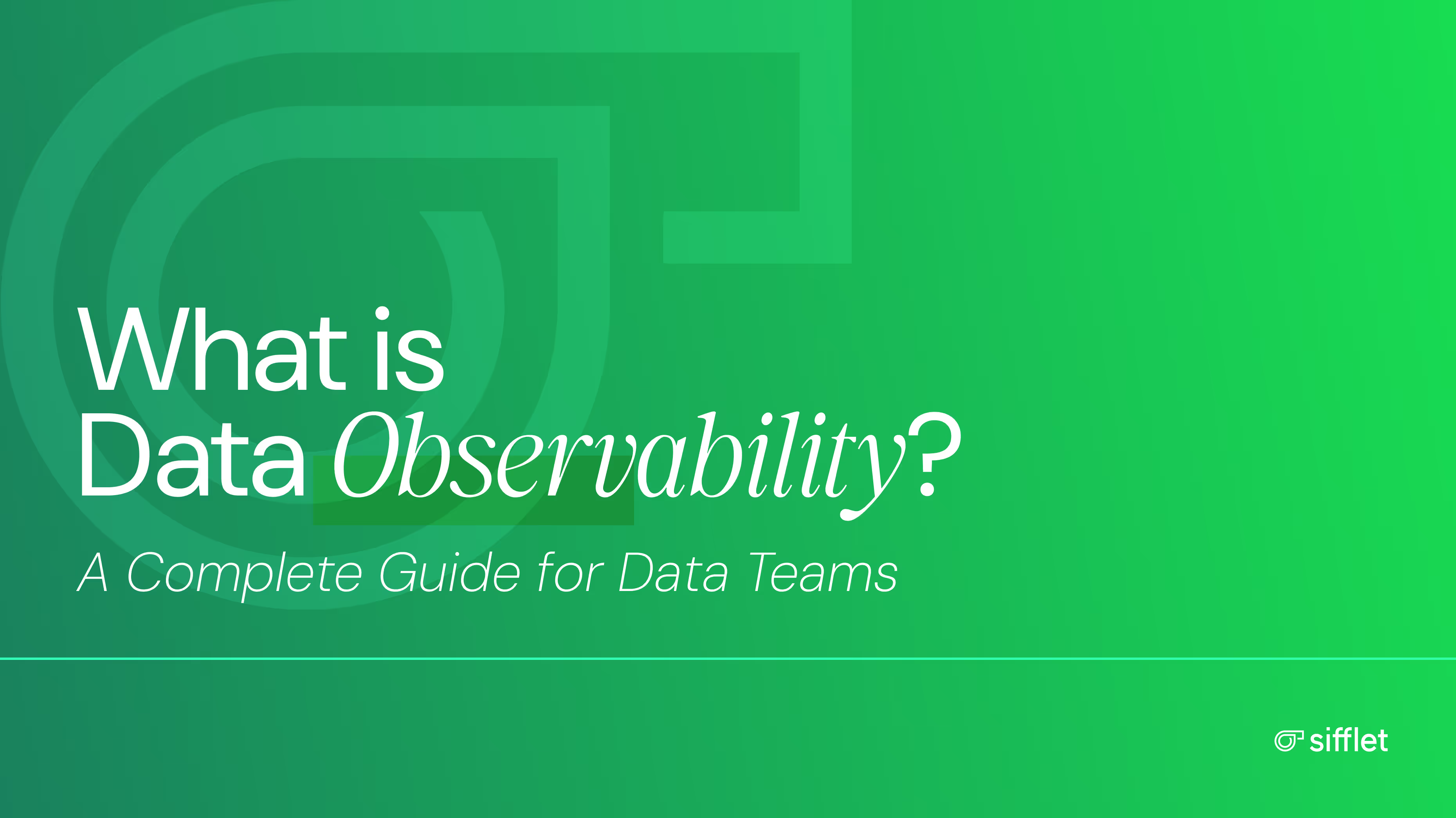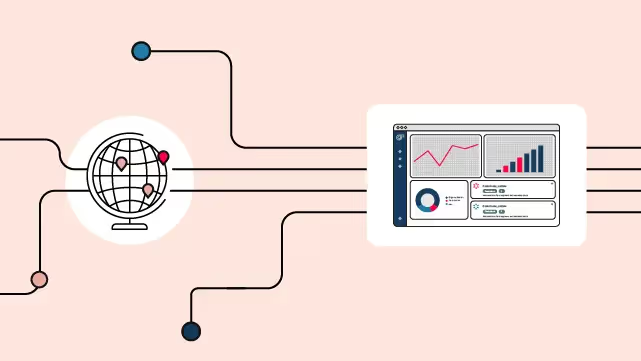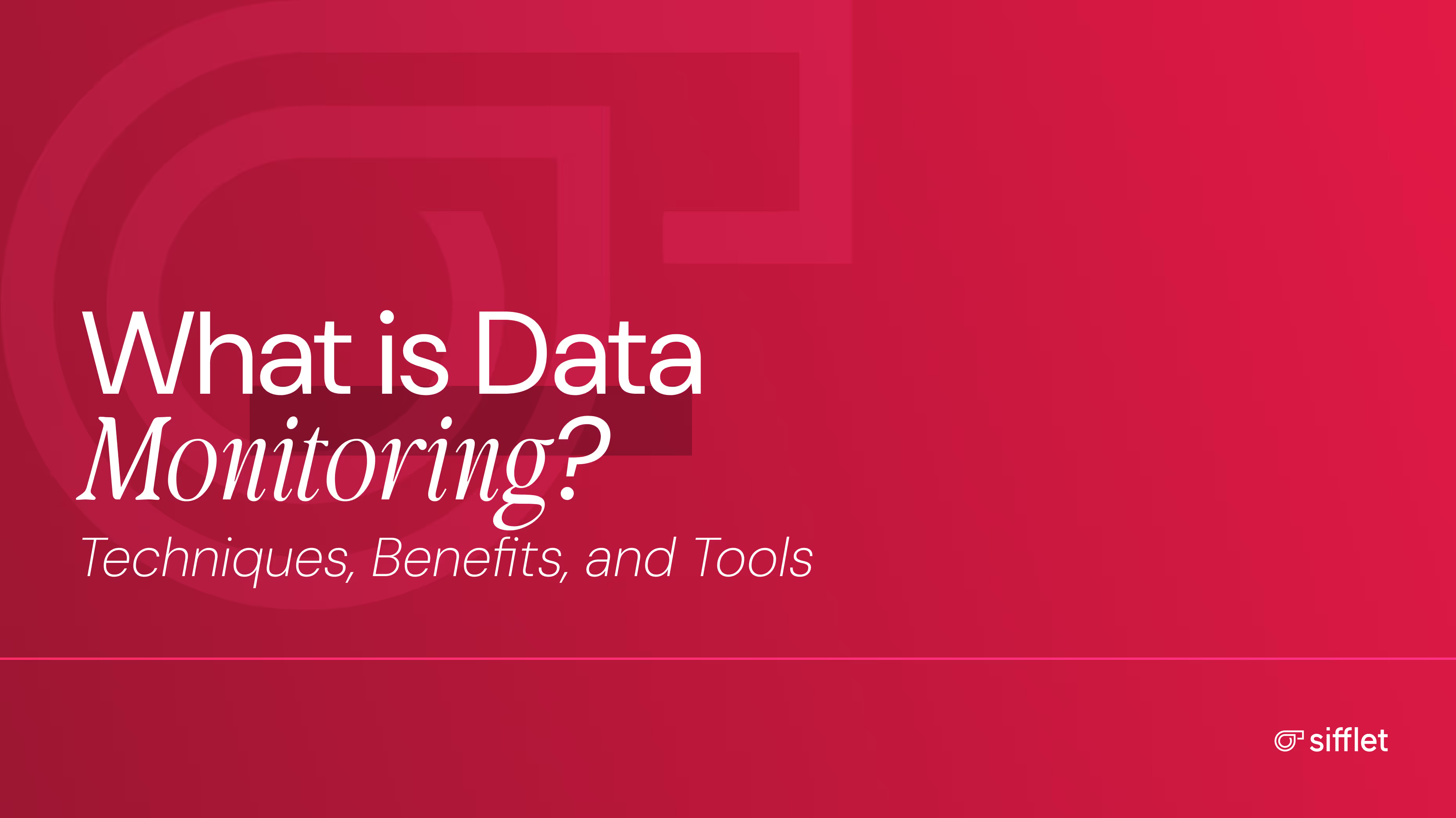At 9 AM, your dashboard shows smooth operations, but by noon, you realize half your sensor data never arrived. There’s no error message and no red flag, just missing numbers and downstream confusion.
This isn’t a bug in UI, it’s a gap in your data pipeline and it likely started with one of the most overlooked dimensions of data quality: data volume.
The problem is that your business decisions are only as good as the data behind them, so data volume issues can quietly sabotage everything from revenue forecasting to regulatory compliance.
Leading data teams monitor if the right amount of data is showing up, consistently and on time by relying on a broader framework: data observability.
The 5 Pillars of Data Observability (and Why Data Volume Matters Most)
Data observability is your early warning system for data quality issues.
It gives teams visibility into what’s flowing through their pipelines (and what isn’t) so problems can be caught upstream, long before they reach an executive dashboard or ML model.
At the technical level, observability is held by 5 pillars:
- Schema → Is the data structured and typed correctly?
- Volume → Are you receiving the right amount of data?
- Freshness → Is the data arriving on time?
- Distribution → Do values fall within expected ranges?
- Lineage → Can you trace where the data came from and how it’s been transformed?
Together, these signals form the foundation to assess technical data health. They help engineering teams detect schema drift, failed jobs, delayed ingestion, and unexpected transformations.
But here’s the nuance: healthy pipelines don’t always mean trustworthy data.
Your data can be fresh, complete, and correctly structured and still be wrong.
Maybe it’s misaligned with business logic and reflects the wrong metric definition. Or maybe the data is technically sound but operationally useless. That’s why mature data teams don’t stop at technical signals. They layer in business context to understand not just what broke, but who it affects and what’s at stake.
However, when something does go wrong, volume is often the first clue.
It’s the pillar most likely to trigger an alert before downstream dashboards break or KPIs misfire. That’s because changes in volume, like missing rows, unexpected spikes, silent drops, tend to surface faster and are more visible than other kinds of failures.
But what exactly is data volume? And why does monitoring it matter so much?
What Is Data Volume (AKA Your First Line of Defense)
Among the five technical pillars, volume is often the earliest signal that something’s gone wrong.
A sudden drop in row count, a spike in duplicates, or a subtle shift in historical trends can quietly break downstream logic, long before errors surface in a dashboard.
So what exactly is data volume in the context of observability?
Essentially, it’s about monitoring the quantity of data flowing through your pipelines, ensuring you’re receiving the right amount of information, from the right sources, at the right time.
Unlike traditional system monitoring, which focuses on performance and uptime, data volume observability focuses on the integrity of the data payload itself.
And it answers the kinds of questions that keep data teams up at night:
- Are we receiving the expected amount of data from each source?
- Are there missing records that could skew business analysis?
- Are we seeing unexpected duplicates that might corrupt KPIs?
- Are volume trends consistent with historical patterns?
Example: A fintech company’s fraud detection model expects around 2.5 million transactions per day.One morning, volume monitoring flags a dip to 1.8 million. That’s not a blip, it’s a blind spot that could result in missed fraud, compliance risks, and financial exposure.
Volume gives you a baseline: is the data showing up at all, and in the right amount?
But volume is just one dimension. To fully understand what’s flowing through your pipelines and how to manage it, you also need to distinguish it from data variety, another critical but often confused concept.
Data Volume vs Data Variety
Many teams confuse data volume with data variety, but they're fundamentally different dimensions of your data ecosystem:
While data volume is about how much data you have, data variety is about how many different types of data you're handling.
A healthcare system might have high variety (patient records, lab results, imaging data, billing information) but experience volume issues when appointment scheduling data suddenly drops by 40% due to a system outage.
Understanding how volume differs from variety helps clarify what you're looking for in your data and why.
It’s not enough to recognize volume issues. You need to actively monitor them because volume is often the first and only clue you’ll get before bad data starts slipping through the cracks.
Why Monitoring Data Volume Is Critical for Data Reliability
Data volume is more than a technical metric.
It’s a measure of trust.
When your team asks, “Can we rely on this data?”, they’re not just asking if the pipeline ran. They’re asking if anything went missing, got duplicated, or never showed up at all. Monitoring volume ensures your data reflects reality completely and consistently before it drives business logic, reporting, or decisions.
As we’ve mentioned earlier, when something goes wrong, data volume is usually the first warning sign. Subtle drops, quiet spikes, and baseline deviations surface long before dashboards fail or KPIs go off track.
Monitoring data volume is critical because:
- It builds trust across the business
Every team member, whether they’re in marketing, finance, or operations, assumes the data is complete. They trust that every click, transaction, or shipment is reflected in the numbers.
Volume monitoring reinforces that trust. It tells your team the data is not just present, but whole.
- It catches pipeline failures early
Not every failure throws an error. Sometimes it’s a broken API, a delayed job, or an upstream filter quietly excluding rows.
Volume anomalies are your early detection system. They raise flags when other tools stay silent.
- It prevents costly missteps
If your data is incomplete, your decisions will be too. A logistics team optimizing routes or a pharma company analyzing trials can’t afford missing records.
Monitoring volume ensures decisions are grounded in the full picture, not partial data.
- It protects against compliance risk
In industries where data must be complete, like finance, healthcare, or insurance, missing records aren’t just inconvenient, they’re a liability.
Volume checks help teams catch gaps before auditors do.
How to Monitor and Manage Large Volumes of Data at Scale
As your data ecosystem grows, managing volume becomes increasingly complex.
Here's how successful organizations tackle this challenge:
1. Set up governance and monitoring
Effective data volume monitoring requires more than just tracking numbers, it also needs context.
Data governance policies help teams understand what "normal" volume looks like for each data source and establish clear escalation procedures when volume issues arise.
Metadata and lineage tracking provide crucial context for volume anomalies. When volume drops in your customer analytics pipeline, lineage helps you quickly trace the issue back to its source, whether it's a failed API connection, a database outage, or a change in upstream systems.
Proactive monitoring with business-aware thresholds ensures alerts are meaningful.
Instead of generic "row count down 10%" alerts, effective monitoring considers business context: "Customer sign-up data 30% below Tuesday average, potential impact on growth metrics."
2. Invest in scalable storage and compute
Modern data infrastructure needs to handle volume spikes gracefully. Cloud-native data warehouses like Snowflake and BigQuery automatically scale to accommodate varying data volumes, while data lakes and lakehouses provide cost-effective storage for massive datasets.
A manufacturing company processing IoT sensor data might see 10x volume increases during peak production periods.
Scalable infrastructure ensures these spikes don't break your pipelines or blow your budget.
3. Use a data observability platform
Manual volume monitoring doesn't scale beyond a handful of data sources.
Modern data observability platforms automatically detect volume anomalies, track growth trends across pipelines, and alert teams to unexpected data drops or spikes.
These platforms learn your data patterns and can distinguish between normal business fluctuations (like seasonal sales patterns) and genuine pipeline issues.
4. Track data volume metrics
Focus on metrics that directly impact business outcomes:
- Daily/hourly row count trends: Track the volume of data flowing through each pipeline
- Null or blank field percentages: Monitor data completeness within your volume
- Percentage deviation from volume baselines: Measure how current volume compares to historical norms
- Freshness correlation: Connect volume changes to data timeliness issues
For example, a logistics company might track package scanning events per hour, correlating volume drops with delivery delays to proactively address operational issues.
How Sifflet Helps You Monitor and Manage Data Volume
While building volume monitoring in-house seems straightforward, it quickly becomes complex at scale.
Sifflet provides a comprehensive solution that takes out the guesswork from the equation:
- Plug-and-play monitoring: Connect your data sources and immediately start monitoring volume across tables, pipelines, and tools, no complex configuration required.
- AI-powered baselining: Sifflet's machine learning algorithms automatically learn your data patterns, distinguishing between normal business fluctuations and genuine pipeline issues.
- Business impact connection: Beyond just detecting volume issues, Sifflet helps you understand how data problems impact business outcomes, allowing faster prioritization and resolution.
- Unified monitoring: Track volume issues across your entire data ecosystem from a single platform, whether your data lives in Snowflake, BigQuery, or dozens of other tools.
Ready to make volume issues a thing of the past? Request a demo to see how Sifflet can transform your data reliability from reactive firefighting to proactive monitoring.






%2520copy%2520(3).avif)







-p-500.png)
